Proposed Researches A04 : "Pathological Conditions"
■ Click on title
-
 Neural mechanisms underlying the processing of subjective time in memory and its disturbance
Neural mechanisms underlying the processing of subjective time in memory and its disturbance- Principal Investigator
- Takashi Tsukiura
Associate Prof., Grad. Sch. of Human and Environmental Studies, Kyoto Univ.
-
When we remember remote autobiographical events, we sometimes feel that these events took place more recently than they actually occurred. Such perceptions of our memories suggest that the mental time in our memories may not necessarily be equivalent to the actual time in which the events occurred. In addition, amnesic patients with brain lesions often exhibit the symptom of confabulation, which could be interpreted as the disturbance in adjusting the differences between the subjective and objective times corresponding to memories. The aim of this study is to investigate the neural mechanisms underlying 1) how the subjective perception of time in memories is formed, 2) how the gap between the perceived and actual times that correspond to our memories is adjusted, and 3) how this adjustment process is disturbed in amnesic patients exhibiting confabulation.
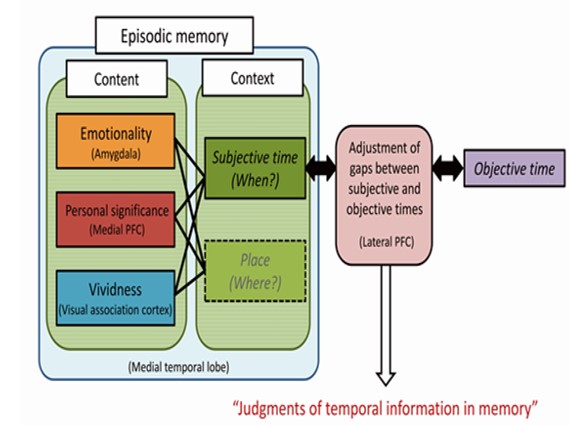
-
 Cognitive neuroscience approach to future cognition: Perspectives from psychiatry and neuropsychology
Cognitive neuroscience approach to future cognition: Perspectives from psychiatry and neuropsychology- Principal Investigator
- Satoshi Umeda
Prof., Department of Psychology, Keio Univ.
-
- Co-investigator
- Yuri Terasawa
Associate Prof., Department of Psychology, Keio Univ.
We have been investigating the neural mechanisms of prospective memory, which is defined as the memory for future intentions in everyday life, as well as temporal estimation and its neural substrates. It appears to be difficult to answer the question of how intended activities are remembered to be executed at the appropriate time by performing research exclusively on human memory functions. To appropriately answer this question, it is important to focus on the bodily responses to autonomic nervous system activities and interoceptive awareness of visceral sensitivity. The current research project will investigate the neural mechanism of future cognition by taking an integrative approach that focuses on the important triad of “mind, brain and body” and will apply this to various psychiatric disorders, including anxiety and depression.

-
 Neuropsychological approach to the study of synchronization phenomena
Neuropsychological approach to the study of synchronization phenomena- Principal Investigator
- Akira Midorikawa
Prof. Faculty of Letters, Chuo Univ.
-
The aim of the study is to investigate self-awareness in the context of interaction and the interaction deficit between oneself and one’s environment. In this study, we hypothesized that self-awareness is an interaction-based phenomenon between oneself and one’s environment, including the surroundings and other individuals and that discrepancies between these phenomena might induce various types of self-awareness disorders. To confirm the hypothesis, we planned three different experiments using different subjects. First, the subjects are patients with frontal lobe disturbances showing “pacing disorder”, desynchronizing with external time schedule. Second, patients with dementia (fronto-temporal dementia: FTD) and developmental disorders (autistic spectrum disorder: ASD) showing “restrict daily timetable”, desynchronizing with others, will be examined. Third, the subjects of the study are patients with corpus callosum damage showing “unilateral tapping disturbance”, deficit of subjective present.
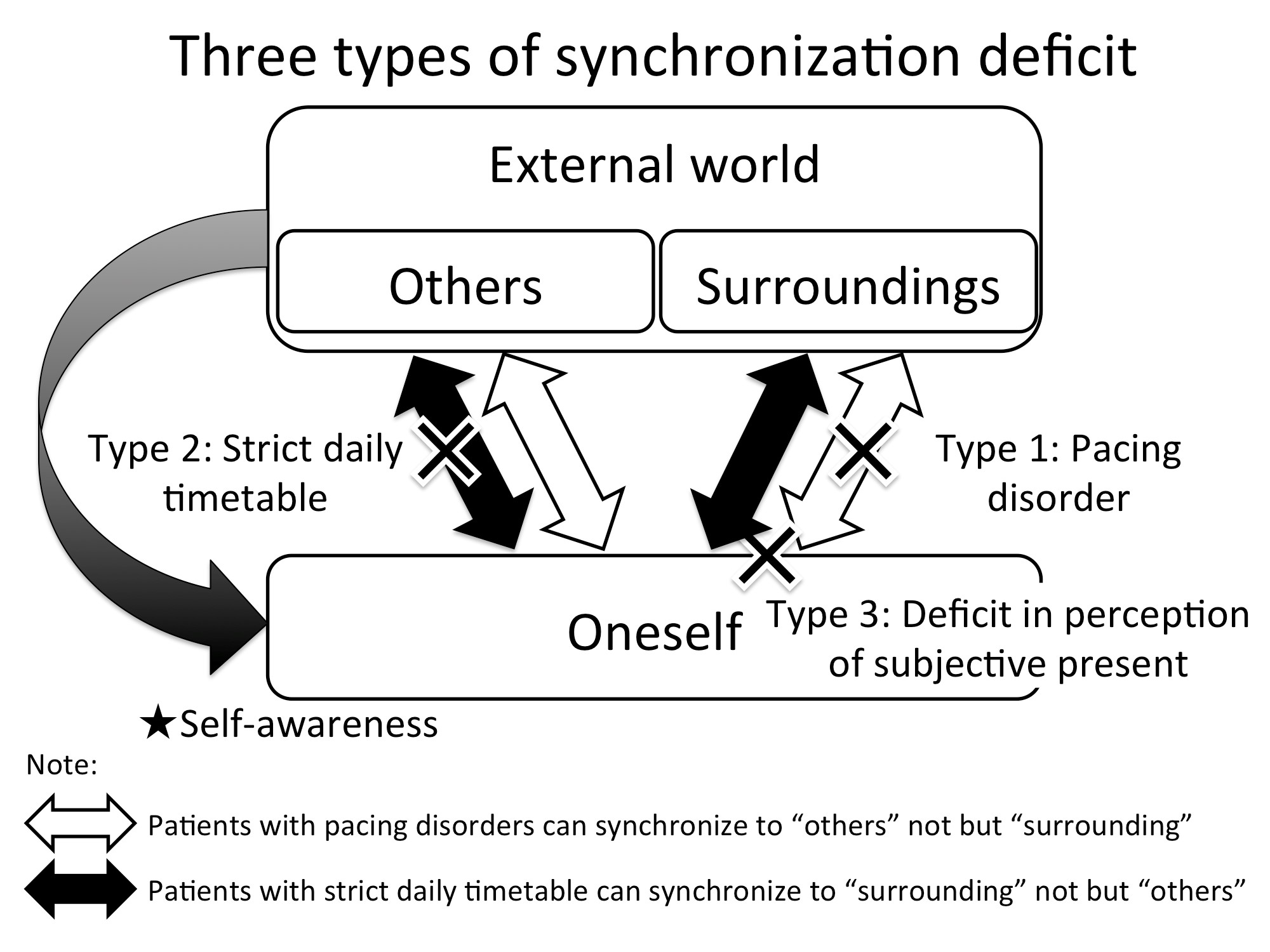
-
 Temporal length of subjective ‘present’ in schizophrenia and its plasticity
Temporal length of subjective ‘present’ in schizophrenia and its plasticity- Principal Investigator
- Sotaro Shimada
Prof., Electronics & Bioinformatics Sch. of Science & Technology, Meiji Univ.
-
- Co-investigator
- Seiya Miyamoto
Associate Prof., Marianna Univ. Sch. of Medicine - Co-investigator
- Noboru Yamaguchi
Prof., Marianna Univ. Sch. of Medicine - Co-investigator
- Nobumi Miyake
Associate Prof. Marianna Univ. Sch. of Medicine
This study investigates the temporal length of the subjective ‘present’ in perception and its plasticity by employing self-body recognition experiments, with a special emphasis on visuo-tactile integration. In particular, we are examining the relationship between the psychiatric states of schizophrenia and the temporal length of their subjective ‘present’, and we are exploring the possible application of these findings to medical treatment. The rubber hand illusion (RHI) is a subject’s illusion of the self-ownership of a rubber hand that is touched synchronously with their own hand. In this study, we conduct RHI experiments under the visual feedback delay of the hand image while measuring the activation of the parietal lobe via near-infrared spectroscopy (NIRS). We are also investigating the ability of transcranial direct current stimulation (tDCS) over the parietal lobe to recalibrate the length of the subjective ‘present’ based on RHI experiments.

Proposed Researches B01 : "Linguistics and Philosophy"
-
 Temporality in Self-Consciousness
Temporality in Self-Consciousness- Principal Investigator
- Yukihiro Nobuhara
Prof., Grad. Sch. of Arts & Sciences, Univ. of Tokyo
-
- Co-investigator
- Yasuo Nakayama
Prof., Grad. Sch. of Human Sciences, Osaka Univ. - Co-investigator
- Takahiro Isashiki
Prof., Nihon Univ. College of Economics
We perform philosophical investigations into the essential connection between “the self in the mind” (self-consciousness) and “the time in the mind” (the experience of time). In particular, we are developing a philosophical theory of the self which can explain neurological findings about representations of time in the brain, and based on this theory, we are clarifying fundamental temporality of the self. The following two sub-goals are pursued in these investigations. First, we are elucidating the temporal duality of self-consciousness. We theorize self-consciousness as comprising two types of self, the phenomenal self, which consists of perceptions of the present time and the narrative self, which contains experiences of the past, present and future times. Each self is supposed to correspond to some representation of time in the brain. Second, we are elucidating temporality of self-control, which is a fundamental aspect of the self. We theorize self-control as the integration of the phenomenal and the narrative selves, clarifying its essential temporality.
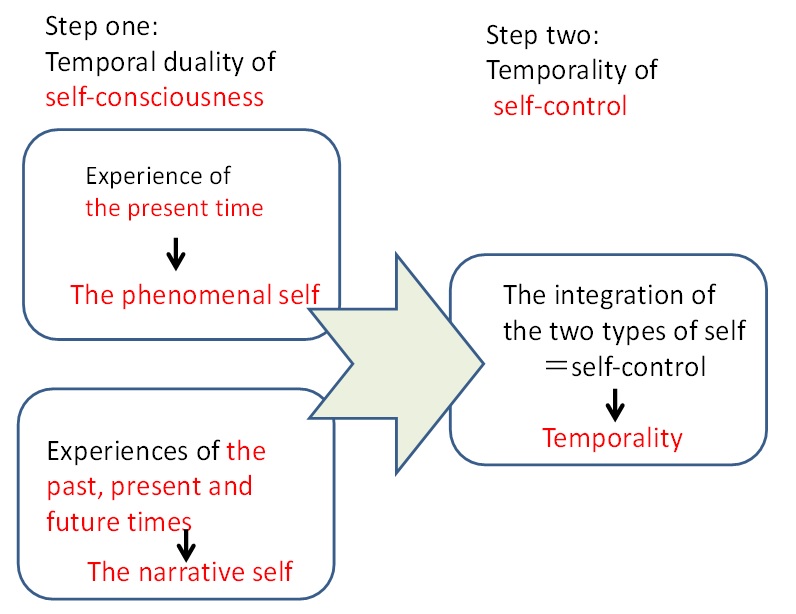
-
 Linguistic and cultural influences in decision-making: Examination of time discounting
Linguistic and cultural influences in decision-making: Examination of time discounting- Principal Investigator
- Keiko Ishii
Associate Prof. Grad. Sch. of Humanities, Kobe Univ.
-
- Co-investigator
- Taiki TakahashiAssociate Prof. Grad. Sch. of Letters, Hokkaido Univ.
People tend to prefer receiving smaller rewards sooner rather than receiving larger rewards later and to discount future outcomes. The present research focuses on future discounting and examines the influence of language and residential mobility and stability. As for the influence of language, we are investigating whether linguistic differences on future-time reference (i.e., whether people are required to speak in a distinct way about present and future events) and use of the first-person singular (1PS) pronouns influence one’s future discounting. We hypothesize that future discounting decreases as the structural and grammatical aspects of language become more future-oriented. As for residential mobility and stability, we hypothesize that future discounting decreases as the residential stability of society increases. The present research examining intertemporal choice will contribute to an improved understanding of the human mind in different social and cultural environments.
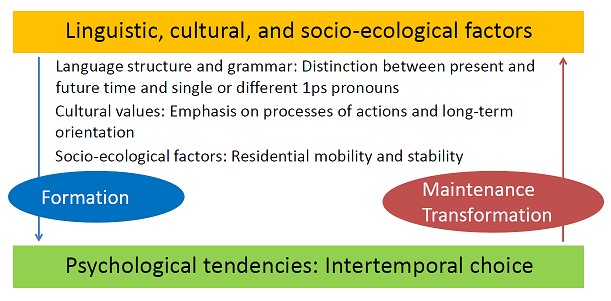
-
 A Linguistic-Philosophical Analysis of Modality Underlying Tense Recognition
A Linguistic-Philosophical Analysis of Modality Underlying Tense Recognition- Principal Investigator
- Takuo Aoyama
Associate Prof. The Research Institute for Time Studies, Yamaguchi Univ.
-
- Co-investigator
- Makoto Miyazaki
Prof. The Research Institute for Time Studies, Yamaguchi Univ. - Co-investigator
- Hiroki Migita
Associate Prof. The Research Institute for Time Studies, Yamaguchi Univ. - Co-investigator
- Shogo Shimizu
Project Assistant Prof. The University of Tokyo for Philosophy
Humans often represent time as a tree diagram of possibilities with branches that diverge from the past to the future. At any point on the diagram, there is a single possible past history; on the other hand, there are many possible future histories. The recognition of tense – i.e., present, past and future – is tightly associated with the modality of possibility. Our research aims to closely analyze the conceptual relationship between the modality of possibility and tense and, furthermore, to investigate the network of ordinary concepts, including freedom, responsibility, happiness, and so on. The functions of these ordinary concepts can be partly reconstructed with the aid of a tree diagram of possibilities. Our primary aim is to determine the significant aspects of the mechanism responsible for rendering mental/linguistic tense to the (time-symmetrical) tenseless physical world, especially from the viewpoint of human recognition of counterfactual possibilities.
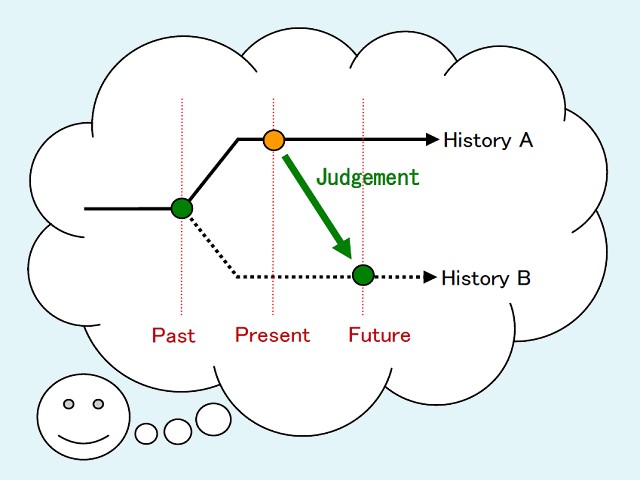
-
 Mapping of event and reference times on the brain via language-elicited EEG
Mapping of event and reference times on the brain via language-elicited EEG- Principal Investigator
- Shingo Tokimoto
Prof. Faculty of Foreign Language Studies, Mejiro Univ.
-
- Co-investigator
- Naoko Tokimoto
Instructor, Policy Management, Shobi Univ.
Although all animals have memories of the past and expectations for the future, human beings bear the peculiarity to verbally communicate this information about events occurring at a time different from the present to others and to describe the event as though the speaker is in a time different from the present. These two types of time are distinguished as 'event time' and 'reference time', respectively. This study is intended to map these two types of time on the brain via language-elicited EEG. An experiment is designed to manipulate the two types of time to coincide during a discourse, in which event time is represented in the first half of the discourse as past, present, and future, and the reference time is represented by one of the indexicals in the latter half. The neural activities corresponding to these two factors are hypothesized to reflect the processing of the two types of time in the brain.

Proposed Researches C01 : "Comparative Ethology"
-
 Evolution of the mind to predict the future: Comparative-cognitive study of predictive token use in groups of chimpanzees
Evolution of the mind to predict the future: Comparative-cognitive study of predictive token use in groups of chimpanzees- Principal Investigator
- Masaki Tomonaga
Associate Prof. Primate Research Institute, Kyoto Univ.
-
- Co-investigator
- Fumito Kawakami
Primate Research Institute, Kyoto Univ./Research Fellowship, Japan Society for the Promotion of Science
In this research project, we will examine the chimpanzee’s ability to predict their future and to regulate their behavior on the basis of those predictions. To accomplish this research goal, we introduce “tokens” to the social group of chimpanzees. A token is a type of “generalized secondary reinforcer” which can be exchanged with a primary reinforce, such as food or water. The introduction of tokens to chimpanzee groups to provide rewards or to activate a computer to perform cognitive tasks can provide various opportunities to investigate “mental time” and “mental space”. First, we will introduce tokens to chimpanzees in an individual-based setting, and then, we will shift the chimpanzees to a social setting. In each of the settings, we will observe the emergence of specific behaviors implying mental time and mental space, such as caching, exchanging between individuals, etc.
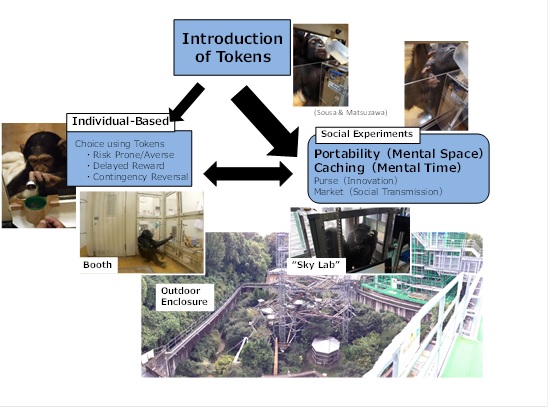
-
 Genesis of the mind that places past and future
Genesis of the mind that places past and future- Principal Investigator
- Kazuo Fujita
Prof., Grad. Sch. of Letters, Kyoto Univ.
-
- Co-investigator
- Hika Kuroshima
Research Fellow, Grad. Sch. of Letters, Kyoto Univ.
Humans place past and future in their mind independent of the present environment. This project will examine whether this ability is exclusive to humans by assessing it in animals of various taxa. This recursive ability makes it possible to draw in mind the agents’ own past experience and future plans; thus, it is one aspect of the self-reflective functions of the mind. Previous studies of episodic memory in nonhumans have aimed to demonstrate the integration of memories of what, where, and when for past events. The incidental nature of encoding events, however, has not been studied intensively. Assessments of the ability to place future are scarce, as well. In this project, we will examine whether and how species adapt their behavior by retrieving memories of individual events (“mind that places the past”), and whether and how they adjust their present behavior by foreseeing future benefits (“mind that places the future”) using human infants, monkeys, rodents, birds, and dogs in a comparative perspective.

-
 Study of interval timing mechanisms along with developmental differences in psychological properties in rats and mice
Study of interval timing mechanisms along with developmental differences in psychological properties in rats and mice- Principal Investigator
- Shogo Sakata
Prof., Faculty of Integrated Arts & Sciences, Hiroshima Univ.
-
This study focuses on the common perception of interval timing in animals, including humans. The perception of time in the range of seconds to minutes is very important in the field of comparative psychology. The commonly used temporal discrimination tasks in animal studies of operant conditioning are the bisection task and the peak interval task. Interval timing is the ability of animals to perceive and process durations in a small range. I focus on comparing the ability of rats and mice to perform interval timing from a few seconds to several tens of seconds, as well as the impact of the developmental stage on this psychological property. I will actively present these results at conferences in Japan and at international meetings. I also plan to submit a publication to a special issue in an academic journal. I am organizing a symposium at the International Society for Comparative Psychology Meeting held at Bogota, Colombia in September 2014. These activities provide a good opportunity for discussion with investigators from all over the world.

-
 Exploring mental time using a temporal discount framework
Exploring mental time using a temporal discount framework- Principal Investigator
- Yutaka Sakai
Prof., Grad. Sch. of Brain Sciences, Tamagawa Univ.
-
Animals often prefer a small reward given immediately to a large reward given later. This preference suggests that an animal might subjectively discount the value of a delayed reward. The temporal profile of subjective discounting is estimated as a hyperbolic function if the reward delay period is considered as a continuously passing interval, whereas it is estimated as an exponential function if reward delay period is considered as a discrete interval. This finding implies that continuous and discrete time may play different roles in temporal discounting. Preferences for delayed rewards have been observed in many species. Therefore, the temporal discounting framework may provide a basis to compare the properties of mental time in different species. We are extending the conventional reinforcement learning theory to a novel framework for temporal discounting in the context of continuous and discrete time, and we have designed an inter-temporal choice task to investigate the properties of continuous and discrete mental time.

Proposed Researches D01 : Neural basis and applications
-
 Neural mechanism of time sense in insect
Neural mechanism of time sense in insect- Principal Investigator
- Hiroto Ogawa
Associate Prof., Fac. of Sciences, Hokkaido Univ.
-
Do insects have ‘time sense’? Insects have a uniquely evolved nervous system, which performs higher brain functions that are equivalent to the mammalian brain, as they exhibit a high level of social behavior, spatial learning, and cognition of the equivalence of stimuli. Honeybees indicate distance from their nest to a feeding site by duration of wing beat during the waggle dance. These findings suggest that insects recognize the time of specific stimulus, but it was unknown whether they have ‘time sense’ regarding the temporal pattern of neutral stimuli unrelated to innate behavior. To answer this question, we are subjecting crickets to two types of auditory discrimination tasks. The first task involves the discrimination of tone duration, and the second task involves the detection of stimulus omission in repetitive sound pulses. Furthermore, we are recording the neural activities encoding the inclusion or omission of predicted stimuli from the brain or the prothoracic ganglia during these tasks to clarify the neural mechanism involved in the ‘time sense’ of insects.
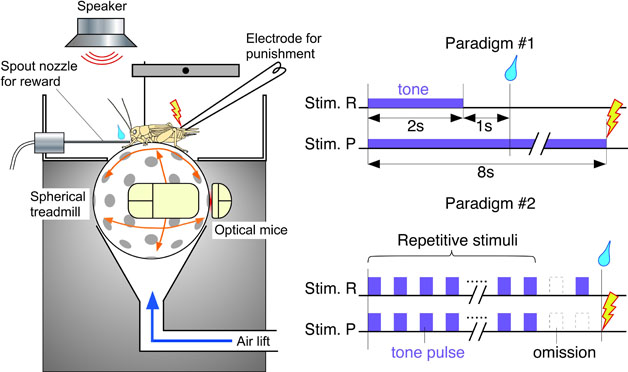
-
 A feedback circuit that controls long-term memory
A feedback circuit that controls long-term memory- Principal Investigator
- Hiromu Tanimoto
Prof., Grad. Sch. of Life Sciences, Tohoku Univ.
-
Animals acquire memories based on their past experience to guide their future behavior. In fruit flies, a single presentation of a sugar reward paired with an odor induces robust short- and long-term olfactory memories. While recent studies have revealed the molecular and cellular mechanisms of long-term memory formation induced by repetitive training, how a stable memory is acquired by a single training session is poorly understood. In many animals, reward is signaled by dopamine neurons in the brain. Here, we investigate a recurrent neuronal circuit for the formation of appetitive long-term memory in Drosophila. The feedback circuit consists of reward-signaling dopamine neurons and neurons that send synaptic output back to the dopamine neurons. Using a combination of anatomical and behavioral analyses, we examine the hypothesis that this feedback circuit plays a role in the stabilization of olfactory memory.

-
 Exploring the effect of the brain serotonin level on time perception and estimation
Exploring the effect of the brain serotonin level on time perception and estimation- Principal Investigator
- Takashi Mizuhiki
Assistant Prof., Faculty of Medicine, Univ. of Tsukuba
-
- Co-investigator
- Munetaka Shidata
Prof., Faculty of Medicine, Univ. of Tsukuba
Although unrealistic optimism pervasively biases perceptions by normal individuals, dysthymic individuals exhibit a more realistic perception, referred to as “depressive realism”. This characteristic has been demonstrated in the time estimation task and other perception-related tasks. By contrast, behavioral analyses using a conventional mathematical model show that the value of a future reward becomes more discounted at lower serotonin levels. This model is consistent with clinical observations, in which both low serotonin levels and enhanced impulsivity are concurrently exhibited by depressed individuals. To bridge the gap between these concepts, we propose the following hypotheses: 1.) a decreased serotonin level improves time perception ability; 2.) this improvement allows depressed individuals to correctly estimate the time until a far future reward, decreasing the incentive for further reward; and 3.) the mathematical model interprets this decreased incentive as steepened temporal discounting. Our approaches to investigate these hypotheses are to perform pharmacological and behavioral experiments to determine the effect of serotonin on the time perception ability of monkeys.
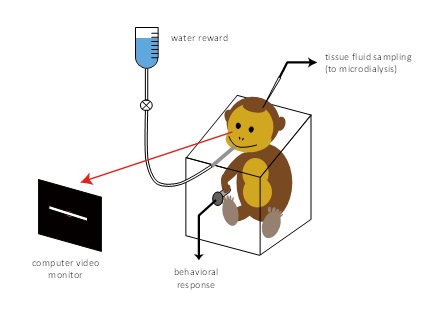
-
 Development of the human interface which enumerates and visualize mental time base on language processing
Development of the human interface which enumerates and visualize mental time base on language processing- Principal Investigator
- Mihoko Otake
Associate Prof., Grad. Sch. & Faculty of Engineering, Chiba Univ.
-
米国の精神科医バトラーは,高齢期の自伝的回想が,自我の統合を促し,うつ病の治療や症状の緩和といった効果が期待できることを指摘した.以降,積極的な回想を促す回想法の研究と実践が,世界各地で行われてきた.近年,肯定的な過去と未来をバランスよく見渡すことを好む人は,幸福感,健康,自尊心が高いことが明らかにされた.この結果は,主観評価により得られたものである.実際,健常高齢者同士の会話を観測してみると,遠い過去を頻繁に話題にする人もいれば、過去から未来までダイナミックに話題が変化する人もいる.しかし,会話における発言の内容からこころの時間を推定する手法は,システム化されていなかった.そこで本研究では,自然な会話における発言に含まれる時間情報を計数,可視化することで,こころの時間を計測評価するインタフェースを開発する.

-
 Neuronal activity in the past, present and future and memory formation
Neuronal activity in the past, present and future and memory formation- Principal Investigator
- Hiroshi Nomura
Assistant Prof., Grad. Sch. of Pharmaceutical Sciences, Univ. of Tokyo
-
Neural activities spontaneously persist in the absence of external stimuli. The present neural activities at a specific time point are thought to be determined by computing the past spontaneous activities and the external stimuli, then regulating future neural activities via structural changes. This computation most likely contributes to memory formation and retrieval. Our study focuses on the following two issues. (1) Learning triggers the rapid, activity-dependent expression of immediate early genes. In addition, long after learning, the expression of immediate early genes is induced in the absence of external stimuli. We will examine the effect of this spontaneous gene expression on the reorganization of neuronal circuits and the subsequent behaviors. (2) We will examine the relationship between spontaneous neuronal activity and neuronal activity in response to external stimuli. We will measure neuronal activity before and during learning and determine the relationship between the past, present and future neuronal activities.
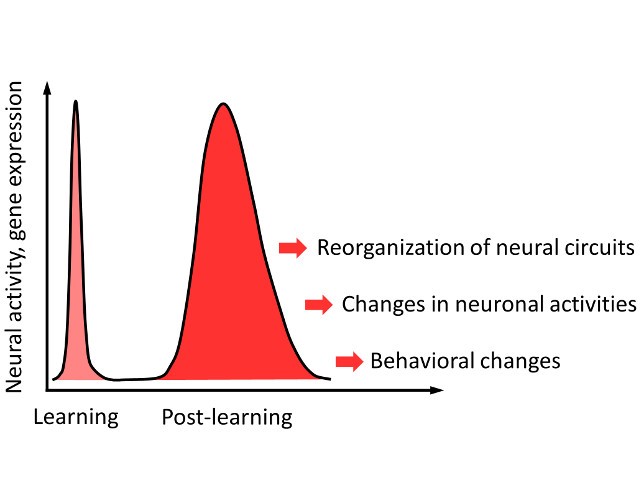
-
 Information processing underlying the temporal continuity of perception: psychophysical analyses using novel illusions
Information processing underlying the temporal continuity of perception: psychophysical analyses using novel illusions- Principal Investigator
- Isamu Motoyoshi
Associate Prof., Grad. Sch. of Arts & Sciences, Univ. of Tokyo
-
- Co-investigator
- Takao SatoProf., Grad. Sch. of Human & Sociology, Univ. of Tokyo
Our perception is stable and continuous in time. Despite repeated disruptions of retinal images by blinks and eye movements, we rarely notice the discontinuities of a visual scene. Whereas the sensory attributes of a single stimulus are represented at disparate timings in the brain, we steadily see an integrated object at a single 'perceptual moment' in a range of a few hundred milliseconds. Even for longer events that last beyond this range, we perceive smooth changes and movements of the scenes. In the present study, we are investigating the computational principles underlying the temporal continuity of perception by analyzing novel visual illusions, such as 'illusory discrete motion', wherein a smoothly moving object appears to jump intermittently.

-
 Neural Mechanisms for time buffering: Function of the posterior cingulate cortex circuitry contributing to the time discrimination behavior
Neural Mechanisms for time buffering: Function of the posterior cingulate cortex circuitry contributing to the time discrimination behavior- Principal Investigator
- Kazuo Okanoya
Prof., Grad. Sch. of Arts & Sciences, Univ. of Tokyo
-
- Co-investigator
- Tohru Kurotani
Research Fellowship for Young Scientists., Grad. Sch. of Arts & Sciences, Univ. of Tokyo
A distinctive feature of the rodent granular retrosplenial cortex (GRS), a part of the posterior cyngulate cortex, is an accentuated layer 2, consisting primarily of closely packed, callosally projecting small pyramidal neurons. In the rat, these layer 2 neurons form prominent patchy clusters, and their apical dendrites receive dense thalamic inputs in layer Ia. Recently, we have demonstrated that these neurons display a distinctive late-spiking (LS) firing pattern, in which an initial rapid rise in membrane potential is followed by a slowly ramping depolarization that leads to the firing of an action potential near the end of a just-threshold current step. We suggested that this LS property might facilitate the comparison or integration of synaptic inputs during an interval delay. The aim of this study is to elucidate the role of the GRS in time discrimination behavior using multiple investigation methods, such as Ca- or voltage-sensitive dye imaging combined with whole-cell patch clamp recording in slice preparations, in vivo multi-unit recordings during dime discrimination behavior and activity pattern analysis of LS neuron clusters during a time discrimination task, with respect to immediate early gene expression.

-
 Modeling study of the representation of time by gradual shifts in the active neuron population
Modeling study of the representation of time by gradual shifts in the active neuron population- Principal Investigator
- Tadashi Yamazaki
Assistant Prof., Grad. Sch. of Faculty of Information & engineering, Univ. of Electro-Communications
-
In this study, we consider the dynamics of a recurrent network composed of inhibitory neurons that exhibits gradual shifts in the active neuron population over time. On the basis of this concept, we have constructed a cerebellar model that represents time with millisecond precision for precise motor control. We will extend this concept and construct a basal ganglia model that represents time for the approximately tens of seconds necessary for time perception. We will theoretically examine how these two structures cooperate and complement one another to precisely represent long time periods.
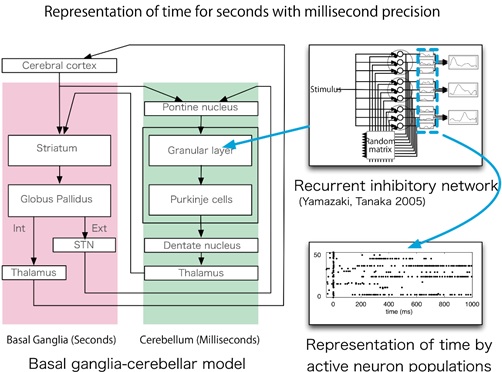
-
 The temporal window of communication emerges via neural synchrony
The temporal window of communication emerges via neural synchrony- Principal Investigator
- Hiroaki Mizuhara
Associate Prof., Grad. Sch. of Informatics, Kyoto Univ.
-
- Co-investigator
- Keiichi KitajoVice team leader., Rhythm-based Brain Information Processing Unit, Riken Brain Science Institute
Neural synchrony is a possible mechanism of dynamically emerging cortical networks for appropriate information processing. Neural synchrony may provide a common mechanism to explain communication not only between regions in the brain but also between brains (i.e., inter-personal communication). In the situation of vocal communication, speech rhythms can synchronize with the neural oscillations of the listener’s brain. This neural oscillation can modulate the intelligibility of sound detection and may be involved in the prediction of speech onset. These findings lead us to hypothesize that the neural synchrony of speech onset is a crucial process that defines the temporal window for inter-personal communication. Here, we will perform a cutting-edge brain imaging technique using the simultaneous fMRI-EEG to elucidate our hypothesis.
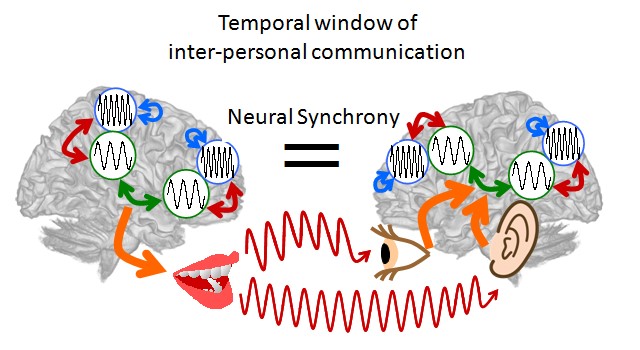
-
 Mental mechanism of perspective taking based on temporal information in narrative comprehension
Mental mechanism of perspective taking based on temporal information in narrative comprehension- Principal Investigator
- Hidetsugu Komeda
Associate Prof., Hakubi Project, Kyoto Univ.
-
Readers need to represent temporal information while reading stories. It is difficult for individuals with autism spectrum disorder (ASD) to take others’ perspectives. One of the reasons for this deficiency is based on the difficulty in sharing temporal information with other people. It is known that some individuals with ASD exhibit a symptom referred to as the “time slip phenomenon” (Sugiyama, 2000), which is an example that characterizes the abnormality in integrating temporal information in a spatial layout. To examine the psychological mechanism for perspective taking in narrative comprehension, first, readers’ comprehension of time and space will be examined. Second, the interaction between temporal and emotional information will be investigated. Third, the neural mechanism of perspective taking in individuals with ASD who exhibit normal intelligence, atypical time perspective, and atypical inference for others’ emotions will be examined via functional magnetic resonance imaging (fMRI).

-
 Capturing the "present moment" in the mind—Mechanisms for subjective simultaneity in the brain
Capturing the "present moment" in the mind—Mechanisms for subjective simultaneity in the brain- Principal Investigator
- Makoto Miyazaki
Prof., Faculty of Informatics, Shizuoka Univ.
-
- Co-investigator
- Hirofumi SekiguchiAssociate Prof., Faculty of Business Information Sciences, Jobu Univ.
- Co-investigator
- Shigeki TakeuchiAssociate Prof., Faculty of Business Information Sciences, Jobu Univ.
- Co-investigator
- Takanori KouchiyamaResearcher, Advanced Telecommunications Research Institute International
- Co-investigator
- Hiroshi KadotaAssociate Prof., Kochi Univ. of Technology
- Co-investigator
- Yuki YamadaAssociate Prof., Faculty of Arts & Sciences, Kyushu Univ.
- Co-investigator
- Takahiro KimuraAssistant Prof., Kochi Univ. of Technology
- Co-investigator
- Tuyoshi KurodaPostdoctoral Fellow,Faculty of Informatics, Shizuoka Univ.
―いま,この瞬間をとらえる.― 我々は,この言葉に静止画として切り取られる一コマを思い浮かべる.北澤 (2013) は,"こころの現在" として,Postdictionと呼ばれる知覚遡及効果が生じる0.1-0.5秒という時間域に焦点を当てた.その時間域の知覚機序の探究に貢献してきた有力なプローブタスクの一つが時間順序判断であった.当然,そこには順序が生じる.順序を特定したとき,そこには過去 (あるいは,相対的に未来) が生じる. "こころの現在" の時間幅は,文脈に応じて多様な拡がりを持つが,本研究は,そこに先後関係を含有しない"主観的同時性" に焦点を更に絞り込む.この研究では,心理物理学的手法と神経生理学的測定 (e.g., fMRI, EEG, TMS) を用いて,主観的同時性と関連/因果関係を持つ脳部位・ネットワーク・脳活動動態を特定することを目指す.

-
 Experimental aesthetics of mental time
Experimental aesthetics of mental time- Principal Investigator
- Hideaki Kawabata
Associate Prof., Faculty of Letters, Keio Univ.
-
While painting or photography as a fine art represents a point in a flowing moment of a scene, the representation of these points sometimes affects our perception of time. We perceive time as short when we are happy but as long when we are bored. Thus, our perception of time depends on our emotional state. However, it remains unclear how perceptions of beauty or attractiveness in viewing an art work impact our mental time. Recent studies suggested that beauty or attractiveness could influence the time perception and attentional process of a subsequent event. In this study, by examining how beauty or attractiveness exerts an effect on our mental perception of time, we are elucidating the relationship between aesthetic feelings and mental time via experimental aesthetics.

-
 The mechanisms of the formation of cell assembly sequences that represent temporal information
The mechanisms of the formation of cell assembly sequences that represent temporal information- Principal Investigator
- Shigeyoshi Fujisawa
Team Leader, Brain Science Institute, RIKEN
-
Neuronal representations of specific time points in temporally organized experiences (i.e., time cells and episode cells) have recently been found in the rodent hippocampus. Moreover, neuronal activities that can predict the future behavior of animals have also been reported in the prefrontal cortex and other cortical areas. The important and common properties of these neuronal activities include: (1) these neuronal activities are organized internally and do not require sensory inputs or motor outputs, and (2) these neuronal activities form reproducible sequential activities as a cell population. Thus, the internally organized sequential activities of a neuronal network can represent the temporal information and planned behaviors corresponding to the near future. The aim of this project is to decipher the network mechanisms of the formation of such cell population sequences that represent temporal information.

-
 Neural and molecular mechanisms of the mental time line
Neural and molecular mechanisms of the mental time line- Principal Investigator
- Makiko Yamada
Sub Leader, Dep. of Molecular Neuroimaging, National Institute of Radiological Sciences
-
Time and space are linked in our mind. This is defined as time-space synesthesia, or the “mental time line”. Time-space synesthesia is observed in our language, such as “look forward to”, which indicates a positive expectation in the future. This observation suggests that time-space synesthesia might underlie our cognitive styles and behavioral choices. The current research project aims to 1) clarify how time and space are linked together in our mental representation to influence our behavior and 2) elucidate the neural and molecular mechanisms of the mental time line via the combination of fMRI and PET measurements. These findings will help us to understand how the mental time line and cognition are intertwined from a neuroscience perspective.
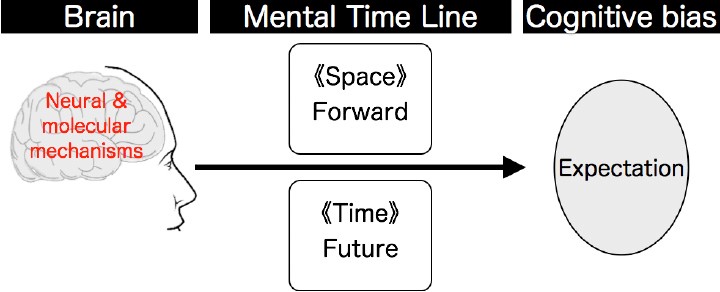
-
 How do human brains connect the dots of memory? – The neural substrates underlying the connection of separate events in memory that were encoded under the same context
How do human brains connect the dots of memory? – The neural substrates underlying the connection of separate events in memory that were encoded under the same context- Principal Investigator
- Mitsunari Abe
Research Fellowship for Young Scientists,Dep. of Neurology,Fukushima Medical Univ.
-
Human brains have the ability to compress past experiences in memory by associating separate events that have occurred under the same context. However, the underlying neural substrates for this behavior are unknown. Sleep can modify newly encoded memories via the reactivation of memory representations. We hypothesize that exposure to the same context during sleep may facilitate the formation of new associations between episodic memories and that synchronized activation of memory representations during sleep may induce the formation of new associations between separate episodic memories. We will 1) assess the causal relationship between exposure to a context during sleep and subsequent behavioral changes related to the formation of new associations and 2) demonstrate that the synchronized activation of brain regions involved in memory can predict the formation of new associations using EEG and functional magnetic resonance imaging techniques. The knowledge acquired from this project may improve our understanding of how human brains compress past experiences that occurred within a large time window.
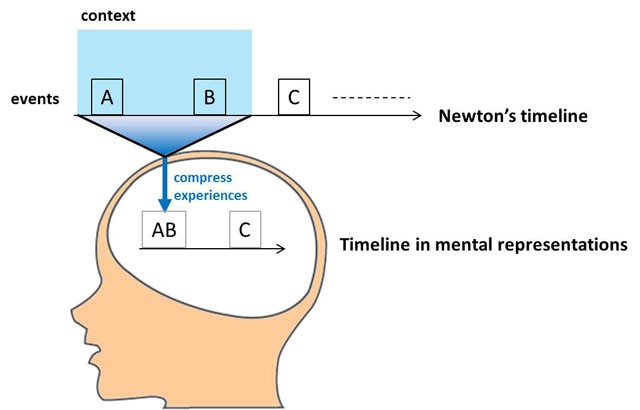
-
 Neural mechanism underling the temporal integration of visual object information
Neural mechanism underling the temporal integration of visual object information- Principal Investigator
- Ryusuke Hayashi
Senior Researcher, Human Technology Research Institute, National Institute of Advanced Industrial Science & Technology
-
Psychophysical evidence suggests that our visual system modifies a percept over time depending on the subsequent events that occur during the next tens of milliseconds to compensate for the time delay related to neural processing, adjusting the “present” percept to the dynamically changing environment. However, the physiological substrate that integrates visual information across time remains unclear. To determine the neural mechanism responsible for retrospectively integrating the perception of the subjective present, we plan to implant multi-electrode arrays into multiple brain areas along the ventral pathway (the primary processing stream for object recognition) and to record neural activity in response to movies that morph from one object to another. Then, we aim to investigate how object representation changes over time at ascending levels of the hierarchy of object recognition via a neural decoding/machine learning method.

-
 Neural mechanisms underlying subjective simultaneity and temporal order
Neural mechanisms underlying subjective simultaneity and temporal order- Principal Investigator
- Shinya Yamamoto
Senior Researcher, Human Technology Research Institute, National Institute of Advanced Industrial Science & Technology
-
To understand the external world, the brain needs to process “when” an event happened, besides “what” it was and “where” it happened. Two sensory signals separated by an interval of a few hundred milliseconds can induce “subjective simultaneity” (whether the two signals were simultaneous) and “subjective temporal order” (which signal was presented first). Despite the significance of these two types of temporal perception, it remains unknown how the brain computes them. In this project, we intend to elucidate the neural mechanisms underlying subjective simultaneity and temporal order, as well as the changes in these two types of temporal perception due to past experiences.

-
 Size of the body constructed using time
Size of the body constructed using time- Principal Investigator
- Nobuhiro Hagura
PhD, Center for Information and Neural Networks (CiNet)
-
We perceive the environment using not only by seeing, but also by touching. The time until a tactile signal reaches the brain differs between body parts, depending on the neural distance from each body part to the brain (conduction delay). For example, even when the wrist and the elbow are simultaneously touched, the signal from the elbow reaches the brain earlier than that of the wrist. Such differences in conduction delay between body parts provide spatial information about the size of the touched object. However, previous studies examining tactile spatial recognition only focused on the information about the direct spatial input from the skin. In this study, we aim to test the hypothesis that the conduction delay difference between the body parts is actively used for the spatial perception of the touched object. In other words, this study investigates how time constructs the spatial metrics of the body.
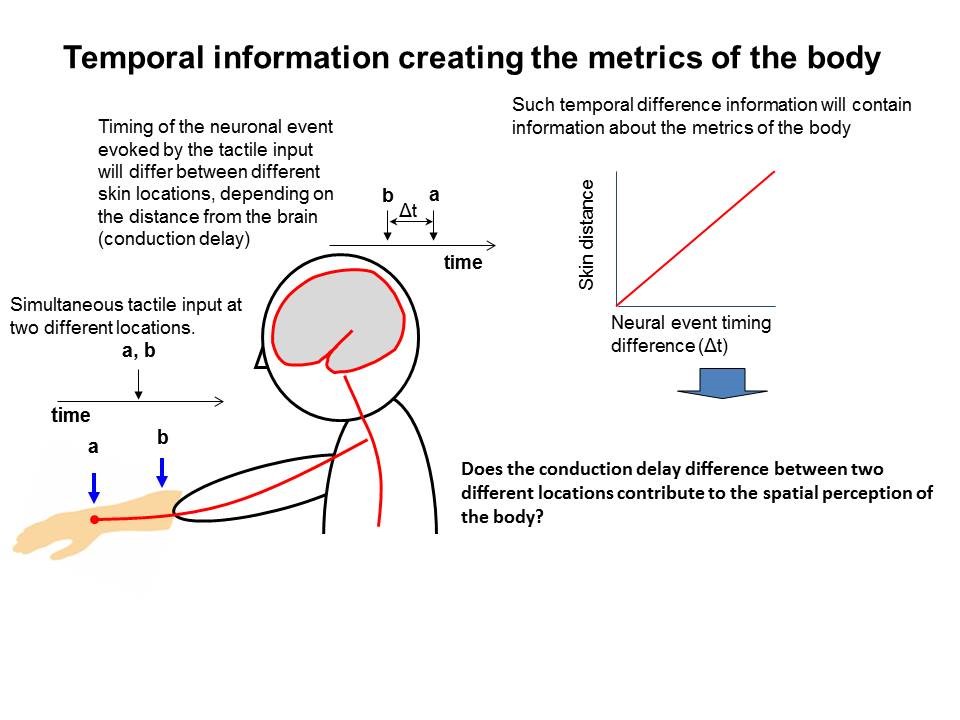
-
 The role of hippocampal newborn neurons in encoding temporal information
The role of hippocampal newborn neurons in encoding temporal information- Principal Investigator
- Shinya Ohara
Research Associate, Tohoku University Graduate School of Life Sciences
-
In our daily life, we can distinguish whether past events occurred around the same time or at a different time. The newborn neurons in the dentate gyrus (DG) of the hippocampus may have a potential role in encoding such temporal information in memory. This hypothesis is based on the developmental properties of the newborn neurons, which show a lower activation threshold and increased levels of long-term potentiation compared to mature granule cells. However, the relationship of newborn neurons to the formation of temporal associations in memory has not been experimentally verified. We have been developing a neural circuit-specific gene delivery method using rabies virus vectors that can transport transsynaptically. In this study, we combine this gene delivery method with optogenetics and electrophysiological and behavioral methods, and we examine the hypothesis that the hippocampal newborn neurons are engaged in encoding temporal information.
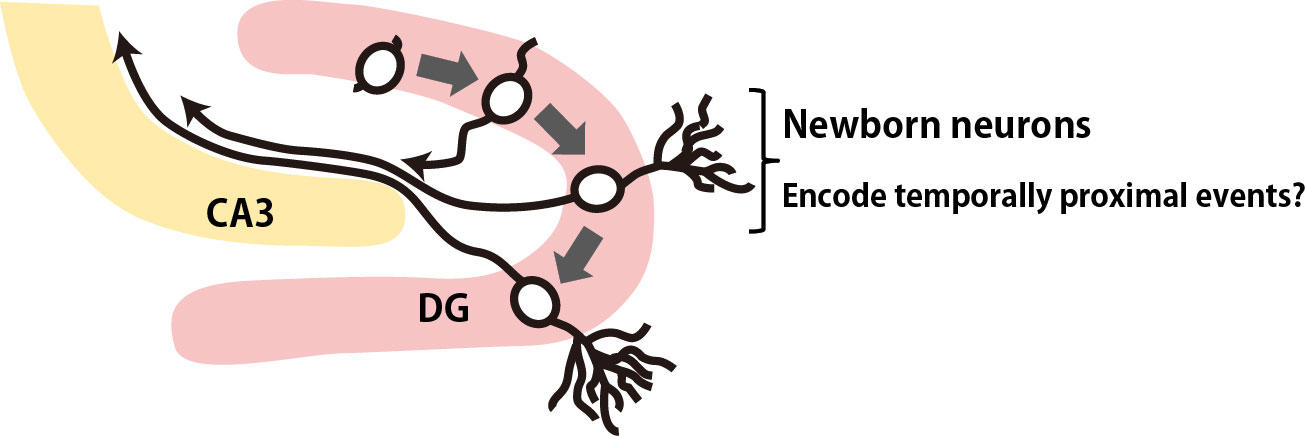
Affiliate
-
 Multineuronal activity in the cortex-basal ganglia system underlying action timing generation
Multineuronal activity in the cortex-basal ganglia system underlying action timing generation- Principal Investigator
- Yoshikazu Isomura
Prof., Brain Science Institute, Tamagawa Univ.
-
- Co-investigator
- Yutaka Sakai
Prof., Brain Science Institute, Tamagawa Univ.
Previously, we have examined the circuit mechanism underlying the spontaneous generation of voluntary movements in the cerebral cortex (e.g., primary motor cortex) and the basal ganglia (striatum) of the rat by combining operant learning tasks using forelimb lever manipulations with multineuronal recording and juxtacellular recording. However, it remains unclear how cortical and basal ganglia circuits generate action timing to execute an appropriate action. In this study, we are aiming to elucidate information processing through interregional circuits in the cerebral cortex and the basal ganglia to generate the action timing to spontaneously initiate a voluntary forelimb movement (in the absence of any stimulus). Our research will provide scientific knowledge to understand mental time in animals and humans.

-
 Neural basis of mental time travel
Neural basis of mental time travel- Principal Investigator
- Yukiyasu Kamitani
Dep. Head, Dep. of Neuroinformatics, ATR
-
The ability to recall past episodes and the ability to simulate future events are hallmarks of human cognition. Recent theories posit that mentations of the past and the future can be understood as components of a more general capacity termed “mental time travel”, and studies found that common brain areas are activated during past- and future-related tasks. However, how the specific mental contents of mental time travel are represented in the brain remains elusive. In this project, using brain decoding methods, we compare fine-grained brain activity patterns during mentations of past and future events with those induced by stimuli or current tasks, revealing the commonalities and differences in neural representations between the past, the present, and the future. These results will lead to a better understanding of the neural basis of human cognitive representations that extend beyond the present.


